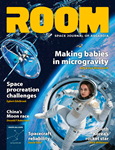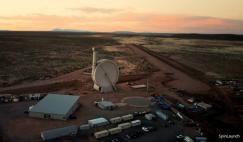The satcoms industry is evolving fast in response to the increased demand for connectivity, higher bandwidth and technological developments. The introduction of software-defined satellites and digital infrastructure is one of the biggest transitions the industry has seen to date. While the shift to digital infrastructures is welcome, because it will herald a new era of flexibility, scalability and responsiveness, it also presents a number of challenges, particularly for the ground segment. Software-defined satellites are already being deployed, and so therefore, the ground segment needs to adapt quickly if it is to support this important transformation.
Conventional geostationary satellites tend to have long design and production cycles, and a lifespan of up to 15 years. They rely mostly on payloads preconfigured to meet the needs of a defined mission. While some hardware functionality can be changed after launch, this is very limited, so their mission must remain the same as was defined before launch. This means that operators have to plan ahead and anticipate future needs and demands during the design stage. Parameters such as frequency, power and footprint are generally ‘locked in’ at launch for the duration of the satellite’s life span.
This rigidity means that operators are unable to change a satellite’s mission and parameters to respond to market shifts and pressures. While this inflexibility was perhaps less of an issue thirty or forty years ago, we now live in a time of extraordinarily fast technological change. A great deal can and does change, including customer needs, in a short space of time, so having a mission locked in for the duration of a satellite’s life is no longer viable.
Software reconfigurability
Software-defined satellites differ from conventional satellites in that their payloads can be easily reconfigured in orbit, as often as several times a day if needed. Frequencies can be updated remotely, power can be redistributed dynamically and beams can be steered ‘on the fly’ according to service requirements. This reconfigurability makes it possible for operators to respond to changing demands with agility, in real-time, as well as service new clients and regions as required. A software-defined satellite’s entire mission can be changed, giving operators ultimate freedom and flexibility.
Not only does this provide satellite operators with a newfound flexibility to reconfigure a satellite already in orbit; it also enables constellations of satellites to be operated and managed as a network.
Ground stations built to support conventional satellites are likewise static, designed and configured to support individual satellites with specific missions and functions. And just as the conventional fixed-payload satellites no longer meet the industry’s needs, nor does the rigidity baked into traditional ground stations. It is fair to say that the rigidity in both space and ground segments has, to a certain degree, constrained satellite communications, making it difficult for the industry to respond to changing customer needs and the evolving communications industry.
As satellites become more flexible and agile, this is changing, but it is crucial that ground infrastructure becomes equally flexible and responsive. That means moving away from fixed-function hardware to software-enabled, virtualised systems able to support the needs of high bandwidth, software-defined satellites and capable of operating as a network.
This new software-defined model brings many benefits. For example, if hardware modems are replaced with software equivalents, it reduces operational costs. Moreover, it becomes possible to run many software models on one server and essentially enable a more agile platform because software modems can be scaled, updated easily and repurposed for new missions as and when required. Additionally, by virtualising the ground segment, operators will also in time be able to leverage the benefits of the Cloud, namely flexibility, scalability, improved operational efficiency, cost effectiveness and advanced automation and management systems.
 Rigidity in both space and ground segments has, to a certain degree, constrained satellite communications. Unfortunately, the process of virtualising the ground segment is far from straightforward.
Rigidity in both space and ground segments has, to a certain degree, constrained satellite communications. Unfortunately, the process of virtualising the ground segment is far from straightforward.
However, if ground infrastructure fails to adapt to mirror the same flexibility and dynamism as software-defined satellites, the evolving space segment’s true potential will not be realised. Unfortunately, the process of virtualising the ground segment is far from straightforward.
Push for Standardisation
If ground infrastructure fails to adapt to mirror the same flexibility and dynamism as software-defined satellites, the evolving space segment’s true potential will not be realised
This shift to virtualisation aligns closely with trends seen in other industries, such as media and broadcast, where core functions such as encoding and decoding are increasingly deployed in software on commodity hardware, or in the Cloud. It is not hard to imagine a future where satellite ground equipment is available as off-the-shelf, general-purpose boxes preloaded with mission-specific software, ready for next-day delivery and remote deployment.
While switchers, channelisers, modems, etc, can all be virtualised, some elements of the ground segment, such as antennas and amplifiers, cannot. Therefore, in order for these components to connect directly to software-based and Cloud infrastructure, radio frequency (RF) signals need to be converted to digital. Moreover, the technology handling this function must work seamlessly with both satellite networks, IP-based networks and Cloud platforms, which is why it is critical that the industry adopts common standards.
Standardisation ensures that different systems can communicate effectively, meet baseline performance expectations and be orchestrated efficiently across platforms. By aligning around shared protocols and frameworks, the sector can build a more cohesive, scalable and resilient operational framework.
The Digital IF Interoperability Consortium (DIFI) is driving standardisation through the development of an open, interoperable digital standard for RF and intermediate frequency (IF) to ensure that signals can be digitised and exchanged reliably across platforms and operators.
Security considerations
While there are a great many benefits to the adoption of software-defined infrastructure, it is important to consider what it means for security.
On the one hand, software-defined systems are more easily updated in response to emerging threats because patching vulnerabilities, implementing encryption protocols and adapting to regulatory changes can be handled with relative speed and precision.
On the other hand, software-based systems introduce new attack surfaces. A virtual modem is only as secure as the software it runs, and every connected node presents a potential entry point for cyber threats. As satellite systems become more interconnected and more reliant on virtual platforms, the need for robust security frameworks becomes even more urgent. Worth noting, however, is that when it comes to cloud-based architecture, Cloud security tools are extremely powerful, and when utilised correctly, can provide a level of security that may be difficult to replicate outside of the Cloud.
What is clear is that, as satellites and ground infrastructure move from being hardware to software-based, the mechanisms that protect them to ensure the integrity and security of the network must also evolve and advance.
 Network orchestration brings the promise of faster data transfer, network redundancy and better resource management across satellite systems.
Network orchestration brings the promise of faster data transfer, network redundancy and better resource management across satellite systems.
Network orchestration
The shift to software-defined satellites also changes the way satellites are managed. Where once, operators simply pointed an antenna and downlinked a known stream of data, satellites today form complex networks and operators need intelligent network orchestration to optimise the service for customers.
This orchestration capability becomes especially important in systems using intersatellite links to transmit data between spacecraft in orbit. Intersatellite links, or satellite crosslinking as it is also known, allow information to be routed across space and downlinked at optimal ground locations, improving efficiency and potentially reducing the reliance on dense ground infrastructure. Intersatellite linking is not new but is currently gaining traction as operators seek ways to manage the complexity of large low Earth orbit constellations without building an equally massive network of ground stations.
The approach, long used for constellations such as Iridium and more recently by Starlink, brings the promise of faster data transfer, network redundancy and better resource management across satellite systems. Government and military programmes are also adopting this model as a way to increase operational resilience and reduce signal delay in mission-critical scenarios.
We are heading towards a future where software-defined satellites become the norm rather than the exception
While intersatellite links reduce the need for dense ground networks, they do not eliminate it. Data must still come down eventually, and when it does the ground segment must be ready to receive, process and distribute it efficiently.
Network orchestration platforms that span both the space and ground segments are emerging as a critical layer in this complex ecosystem. These platforms can be used to coordinate everything from beam steering to adapting downlinks if there is a higher demand in a certain region. Much like the conductor of a symphony orchestra ensures that every instrument plays in time and in tune, network orchestration platforms coordinate each and every network component to ensure that they perform optimally to deliver seamless data flow.
Spectrum management
Another key advantage of software-defined space and ground infrastructure is that it enables a more advanced and dynamic approach to spectrum management. This is critical because, as demand for connectivity increases, the spectrum is becoming congested as well as contested. Not only is the space environment becoming more crowded as record numbers of satellites are launched year on year, which is increasing demand for spectrum allocation, but there are also a variety of new industries and technologies that rely on the spectrum, such as 5G/6G, smart infrastructure, autonomous vehicles and the Internet of Things (IoT). Demand for spectrum is surging from all sides and, as a finite resource, it is critical that it is shared, monitored and managed effectively. While there is undoubtedly a need for improved regulatory frameworks and stronger international cooperation to ensure that this can happen, software-defined space and ground infrastructure will also play a critical role. This is because it delivers a level of flexibility and control that does not otherwise exist, opening the door to a much more sophisticated and dynamic approach to spectrum monitoring and frequency sharing.
 The satcom industry is evolving fast in response to the increased demand for connectivity, higherbandwidth and technological developments.
The satcom industry is evolving fast in response to the increased demand for connectivity, higherbandwidth and technological developments.
Looking ahead
We are heading towards a future where software-defined satellites become the norm rather than the exception. According to one analyst, the global software-defined satellites market was valued at USD 2.68 billion in 2023 and is predicted to reach 8.11 billion by 2031. This equates to an impressive 14.90 percent compound annual growth rate during the forecast period for 2024-2031.
To support this expansion, the ground segment must transform from a static layer of infrastructure into a dynamic, integrated ecosystem. This evolution will be driven not just by technical innovation, but also by changes in business models, regulatory frameworks and operational culture.
We are moving toward a world where ground infrastructure is elastic and on-demand, where updates happen in real time, and where a ground station site might support dozens of different satellite missions on any given day. Achieving this vision will require investment, collaboration and a willingness to break away from legacy ways of working. Just as the shift from hardware to software is redefining the satellite in orbit, it is also redefining the architecture on the ground.
About the author
Rico Behlke is Head of Global Business Development (Teleports) at Quadsat, leading the sales and business development effort focused on teleport customers. An experienced space physicist and space sustainability enthusiast, prior to joining Quadsat, Rico was involved in research projects focusing on communication and navigation at high altitudes and has held previous roles at KSAT (Kongsberg Satellite Services) in Operations and Customer Success Management.














